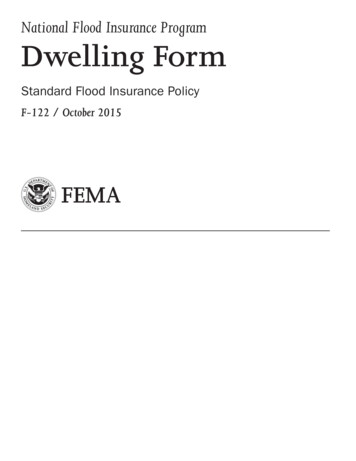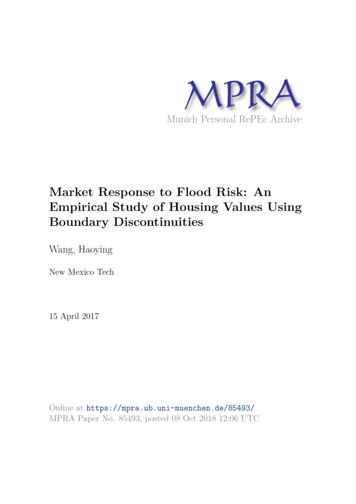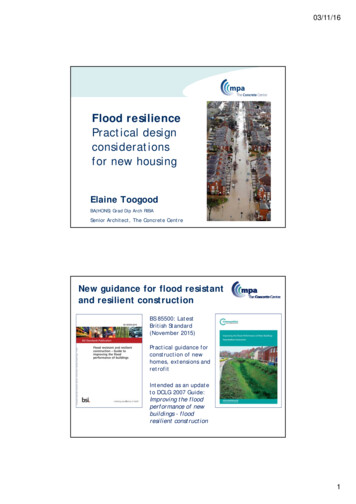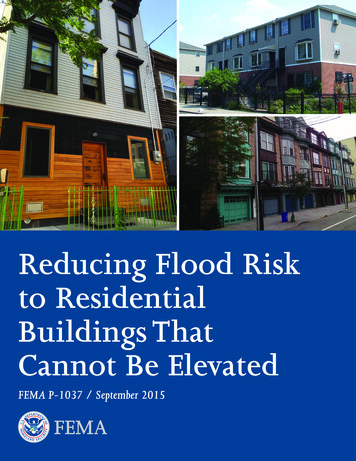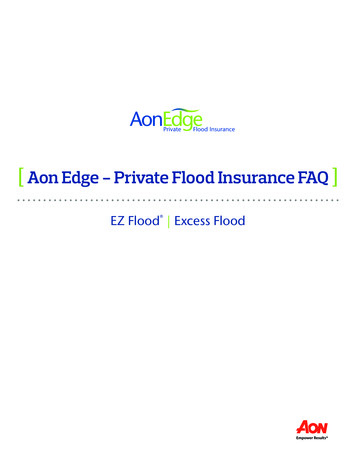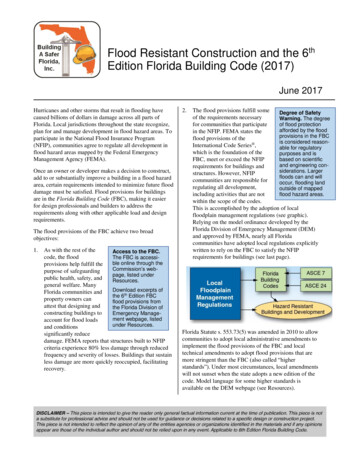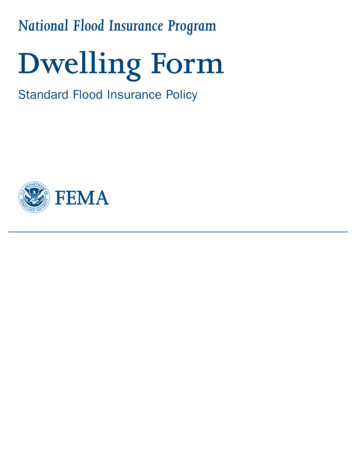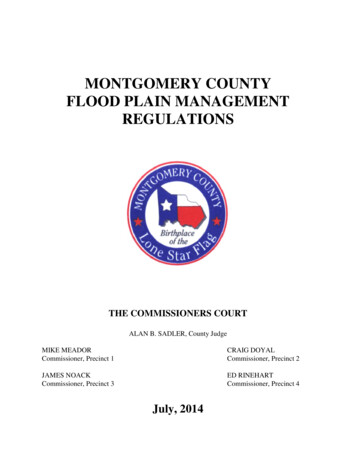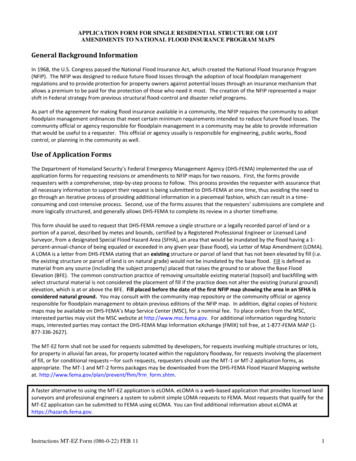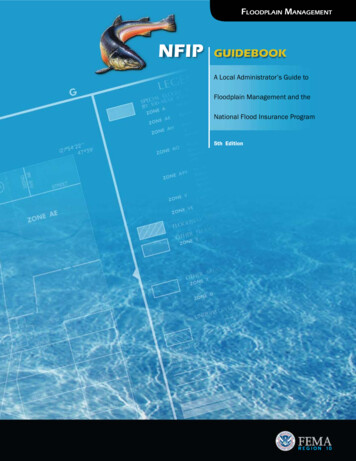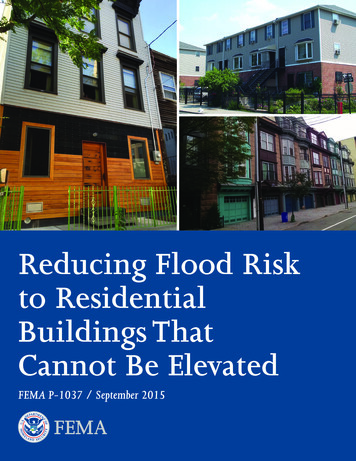
Transcription
Reducing Flood Riskto ResidentialBuildings ThatCannot Be ElevatedFEMA P-1037 / September 2015
Elevated utility readablefrom standing height 6.5' above gradeBasement infillwith gravelApproximate Sandyflood heightFirst floor, approximately 2"above Base Flood ElevationSubgrade flood vents informer basement accessThe dwelling depicted here and on the cover of this publication sustained flood damage during Hurricane Sandy in 2012.The homeownerundertook measures to make the dwelling more flood resistant in the future.The structure was retrofitted using some of the techniques featuredin this publication.These techniques include elevating utilities, basement infill, and installation of flood openings.These combined measures willserve to make the dwelling much more flood resistant and have the added benefit of reducing flood insurance premiums.
Reducing Flood Risk to ResidentialBuildings That Cannot Be ElevatedFloods can happen anywhere at any time, which is whyit is important to be prepared and to take steps before aflood event to protect your property from costly damage.Taking action to reduce the impact of a disaster is known asmitigation. There are a variety of flood mitigation optionsfor homeowners—both for newly built homes as well asexisting homes located in floodprone areas. You may befamiliar with mitigation measures such as elevating a homeabove the Base Flood Elevation (BFE) or relocating a hometo high ground outside of a high risk flood area. Oftentimesit is not feasible to elevate residential structures, therefore,this publication focuses on mitigation measures other thanelevating a home that can be used to protect properties fromflooding, save money over time, and potentially reduceflood insurance premiums.Base Flood Elevation: The height to whichfloodwater is expected to rise during the baseflood—the flood having a one percent chance ofbeing equaled or exceeded in any given year. Areasaffected by the base flood are shown as SpecialFlood Hazard Areas (SFHAs) on FEMA flood maps.In 2014, Congress passed the Homeowner Flood InsuranceAffordability Act (HFIAA). In fulfilment of Section 26of that act, the Federal Emergency Management Agency(FEMA) has established guidelines for property owners that: Provide alternative mitigation methods, other thanbuilding elevation, to reduce flood risk to residentialbuildings that cannot be elevated due to theirstructural characteristics. Inform property owners about how these alternativemitigation methods may affect flood insurance premiumrates under the National Flood Insurance Program (NFIP).NFIP flood insurance premiums are based on a numberof factors, including flood risk zone, elevation of thelowest floor relative to the BFE, the type of building andfoundation, the number of floors, and whether there is abasement or enclosure below an elevated building. Thispublication provides information about measures to reduceflood risks to residential buildings where elevating thehome is not a viable option.Lowest floor: The lowest floor of the lowest enclosedarea (including a basement). An unfinished or floodresistant enclosure, usable solely for parking ofvehicles, building access, or storage in an area otherthan a basement area, and having proper openings,is not considered a building’s lowest floor. Note thatin V Zones if the area under an elevated buildingis enclosed, the bottom of the enclosure would beconsidered the lowest floor.Alternative Options for Reducing YourFlood RiskStructural elevation is a well-recognized measure forreducing flood risk and often the most effective measureto reduce both flood damage and insurance premiums.Buildings that are situated at or above the level of the BFEhave lower flood risk than buildings below BFE and tendto have lower insurance premiums than buildings situatedbelow the BFE. Oftentimes, however, elevation may not bean option if your home has certain structural characteristics.These characteristics may include: attached dwelling units;connected row houses, townhomes, or brownstones; midrise multi-family buildings; older dwellings; and homeswith construction types and/or building materials that arenot suitable for elevation.This publication describes alternative mitigation measuresintended for a variety of housing types that cannot feasiblybe elevated. The guidance applies to a variety of residentialstructures, including single family homes, and many midrise multi-family residential buildings. While the focus ison 1- to 4-family residential buildings that are one to threestories tall, the mitigation measures are applicable to othermulti-family and even high-rise residential buildings.1-4 family home: The NFIP classifies insuredbuildings into several building types. This publicationaddresses 1-4 family homes which include singlefamily detached homes, row houses, townhomes,brownstones and mid-rise multi-family buildings.1
SummaryThis publication presents a range of flood protection measures available as alternatives to traditional structuralelevation for homeowners whose residences meet both of the following conditions:1) The residences are existing buildings. This publication is not intended to address construction of newbuildings in floodprone areas as these structures should be sufficiently elevated and built in conformance withNFIP and local floodplain management regulations.2) The residences are not Substantially Damaged or Substantially Improved, meaning that the buildings have notsustained damage or undergone improvement (i.e., reconstruction, rehabilitation, addition) where the costof the damage or improvement exceeds 50 percent of the market value of the building before the damageoccurred or improvement began. As with new construction, Substantially Damaged or Substantially Improvedstructures must be re-built in conformance with NFIP and local floodplain management regulations.While all of the measures included in this publication can be effective at reducing flood damage, the currentflood insurance rating framework does not provide premium reductions for all of the featured measures at thepresent time. Even if flood insurance premium reductions are not available, there should still be considerationgiven to implementing flood mitigation measures in order to reduce damages and financial losses.The following flood protection measures can be rated under the existing NFIP framework such thatimplementation of these measures may result in flood insurance premium reductions. The amount of thepremium reduction will vary on a case by case basis.All Interior Modification/Retrofit Measures (Basement Infill, Abandon Lowest Floor, and Elevate LowestInterior Floor) and Wet Floodproofing using Flood Openings: These measures can moderately to significantlyreduce flood risk, and the flood insurance rating framework is presently in place to allow homeowners toreceive flood insurance premiums that reflect any flood damage reduction protection provided by thesemeasures. Use of these measures may result in buildings that meet current NFIP minimum requirementsand the local floodplain ordinance, if the lowest floor is elevated to or above the BFE or locally adoptedregulatory flood elevation.The following flood mitigation measures can be used to decrease flood losses and damages. However, FEMAwill need to undertake further analysis to determine whether it is appropriate to offer flood insurance premiumdiscounts for undertaking such measures, and if so, what level of discount is appropriate for each measure.All other Wet Floodproofing Measures (Elevate Building Utilities, Floodproof Building Utilities, and use ofFlood Damage-Resistant Materials): These measures can moderately reduce flood risk and damage toutilities, floors, walls, and other areas subject to flooding.All Dry Floodproofing Measures (Passive Dry Floodproofing System) and Barrier Measures (Floodwall withGates and Floodwall without Gates, Levee with Gates and Levee without Gates): These measures canmoderately to significantly reduce flood risk in areas subject to shallow flooding.A more detailed discussion of each of these alternative mitigation measures and how they reduce flood damagesfollows in subsequent sections of this document.Riverine flooding: Flooding that occurs along achannel, such as a river, creek, stream, or ditch, whenit receives too much water and the excess flows overits banks and into surrounding areas.V Zones: Special Flood Hazard Areas subject to highvelocity wave action.2Coastal A Zones: Inland coastal areas subject to1.5 to 3 foot waves.Floodway: The channel of a river and the adjacentland areas that must be reserved in order to carrythe base flood without increasing flood levels by morethan a designated height, usually 1 foot.
The measures outlined in this publication are designedto address slow moving riverine flooding with minimaldebris—the objects floodwaters pick up, such as rocks, dirt,sewage, ice, and tree branches. Most techniques presentedare not appropriate for high-risk flood hazard areas subjectto wave action (V zones and coastal A zones) or highvelocity flow areas (floodways, areas subject to alluvial fanflooding, flash flood, mudslide, erosion, or ice jam).Selection of Mitigation MeasuresThe ultimate goal of any mitigation measure is to reduce oreliminate the potential of flood damage in a way that is costeffective, complies with all applicable floodplain regulations,and is acceptable to the homeowner in terms of appearanceand livability. The sections that follow include descriptionsof ten flood protection methods. Each description providesinformation needed when considering how to protect yourhome, including design considerations, costs, effectiveness,limitations, and potential effect on flood insurancepremiums (additional detail on premium discounts isprovided on page 2 of this publication). Illustrationsthat show how the methods are applied are also included.In some cases, a single method may adequately addressyour needs. In other cases, a combination of methods maybe best. Keep in mind, the flood protection method chosenmust meet the floodplain management requirements and/or building codes of your local community. The methodsincluded in this publication may not be substituted forbringing a building into compliance with local floodplainregulations following a Substantial Damage or SubstantialImprovement determination by local community officialsexcept where noted.As you will see in the sections that follow, differentflood protection methods protect your home in differentways. For example, when you wet floodproof, you allowfloodwaters to enter your home, but prevent damagebelow a specified elevation by using flood damage-resistantmaterials and construction techniques. When you dryfloodproof your home, you use sealants, shields and othermeasures to protect the part of your home below a specifiedelevation by preventing water from entering the building.Because some seepage is anticipated, sump pumps areused to control the seepage and flood damage-resistantmaterials are used to prevent damage where seepage islikely to occur. When you protect your home with a leveeor floodwall, the top of the levee or floodwall is constructedto a specified elevation. Other approaches include filling ina basement or abandoning the bottom floor. For all of theseflood protection methods, the greatest flood damage andflood insurance premium reductions will be achieved byfloodproofing to/or elevating to or above the BFE.About the NFIPIn most communities throughout the UnitedStates, construction in floodplains is governed bycombinations of Federal, State, and local regulation.At the Federal level, FEMA administers the NFIP.The NFIP is a voluntary program for communities.Its goal is to reduce the loss of life and the damagecaused by flooding, to help the victims of floods,and to lower the costs of flood damage borne by thetaxpayer. Communities that participate in the NFIPtake action in several ways: Guide future development away from floodhazard areas. Require that new buildings, SubstantiallyImproved existing buildings, and repair ofSubstantially Damaged existing buildings inthe SFHA be constructed in compliance withfloodplain management ordinance, regulation, orprovisions of the building code intended to reduceflood damage.Dry floodproofing: Sealing your home to preventfloodwaters from entering.Wet floodproofing: Making portions of your homeresistant to flood damage and allowing water toenter during flooding.Flood damage-resistant material: Any buildingproduct (material, component, or system) capableof withstanding direct and prolonged contact withfloodwaters without sustaining significant damage.Examples may include flood damage-resistantbuilding finish materials such as non-paper-facedgypsum board and terrazzo tile flooring versustraditional drywall and carpeted flooring.Substantial Damage: Damage of any originsustained by a building whereby the cost of restoringthe building to its before-damaged condition wouldequal or exceed 50 percent of the market value ofthe building before the damage occurred.Substantial Improvement: Any reconstruction,rehabilitation, addition, or other improvement of abuilding, the cost of which equals or exceeds 50percent of the market value of the building beforethe start of construction of the improvement.3
Modifying a home to protect it from flood damage requiresextreme care, will require permits, and may also requirecomplex, engineered designs. Therefore: Engage a “design professional” meaning an architect or anengineer who is qualified to deal with the specifics of aflood mitigation project, Check your community’s floodplain managementordinances, Check whether government grants are available, Hire a qualified contractor, Obtain a building permit, Determine whether the mitigation project will trigger aSubstantial Improvement declaration, See the project through to completion, and Obtain an elevation certificate and an engineeringcertificate (if necessary).Interior Modification/Retrofit MeasuresInterior modification and retrofitting involves makingchanges to an existing building to protect it from flooddamage. When the mitigation is properly completedin accordance with NFIP floodplain managementrequirements, interior modification/retrofit measures couldachieve the somewhat similar results as elevating a homeabove the BFE.Keep in mind, in areas where expected base flood depthsare high, the flood protection techniques below alone mayFigure 1: Basement infill before and after mitigation4not provide protection to the BFE or, where applicable, thelocally required freeboard elevation.Basement InfillThese measures involve filling a basement located belowthe BFE to grade (ground level) (Figure 1). Sections ofthe basement walls that remain above ground must beretrofitted with flood openings that allow automatic entryand/or exit of floodwaters (refer to the Flood Openingssection for details). Any basement utility systems andassociated equipment must be elevated to protect utilitiesfrom damage or loss of function from flooding (refer to theElevate Building Utilities section for details).Effectiveness: Basement infill has been proven to beeffective at reducing damages to building elements andcontents located below the BFE since the lowest floor canpotentially be re-located above the BFE (see Figure 1).Considerations: Homeowners must be careful to install andmaintain flood openings that open automatically during aflood event when needed.Infill of basements and, if required, relocation of basementutilities will lead to a loss of square footage and the possibleloss of livable or rentable space within the existing building,which may not be economically feasible for some owners.To compensate for the loss of livable or rentable spacewithin the existing building, additional living space abovethe BFE may be added in the form of an added floor orlateral addition to make up for the loss of the basement.Unfortunately, adding the cost of the additional living spacemay not be economically feasible for some homeownersand may also trigger a Substantial Improvement declaration.
Figure 2: Abandoning the lowest floorCost and useful life: Basement infill is considered arelatively high-cost measure with an expected usefullife of 30 to 50 years and little or no additional annualmaintenance costs beyond maintaining flood openings.Potential impact on flood insurance premiums: Whenthe mitigation is properly completed, a flood insurancepolicy will be rated based on the new lowest floor livinglevel. The higher the reference level of the lowest floor, themore significant the premium rate decreases will be. Actualpremium reductions will vary on a case by case basis asindividual structures are rated.Abandon Lowest FloorThis measure involves abandoning the lowest floor of a twoor more story slab-on-grade residential building (Figure 2).The lowest floor walls must be retrofitted with floodopenings that allow automatic entry and exit of floodwaters(refer to the Flood Openings section for details).Additionally, any utility systems and associated equipmenton the lowest floor must be elevated to protect utilitiesfrom damage or loss of function from flooding (refer to theElevate Building Utilities section for details).Effectiveness: Abandoning the lowest floor of a building hasbeen proven to be effective at reducing damages to buildingelements and contents located below the BFE (see Figure 2).Considerations: Homeowners must be careful to install andmaintain openings that open automatically during a floodevent when needed.Abandoning the lowest floor and, if required, relocationof utilities will lead to a loss of square footage and theprobable loss of livable or rentable space within the existingbuilding, which may not be economically feasible forsome homeowners.To compensate for the loss of livable or rentable spacewithin the existing building, additional living space abovethe BFE may be added in the form of an added floor orlateral addition to make up for the loss of the lowest floor.Unfortunately, adding the cost of the additional living spacemay not be economically feasible for some homeownersand may also trigger a Substantial Improvement declaration.Cost and useful life: Abandoning the lowest floor of abuilding is considered a relatively high-cost measure withan expected useful life of 30 to 50 years and little or noadditional annual maintenance costs beyond maintainingflood openings.Potential impact on flood insurance premiums: When themitigation is properly completed, a flood insurance policywill be rated based on the new lowest floor living level. Thehigher the reference level of the lowest floor is elevated, themore significant the premium rate decreases will be. Actualpremium reductions will vary on a case by case basis asindividual structures are rated.Elevate Lowest Interior FloorThis measure involves elevating the lowest interior floorwithin a residential building with high ceilings (Figure 3).The space below the lowest elevated interior floor wallsmust be either filled to create a stem wall or retrofittedwith flood openings that allow automatic entry and/orexit of floodwaters (refer to the Flood Openings sectionfor details). Additionally, any utility systems and associatedequipment located below the lowest interior floor must beelevated to protect utilities from damage or loss of function5
from flooding (refer to the Elevate Building Utilitiessection for details). To reduce flood damage and floodinsurance premiums to the greatest extent possible, elevatethe lowest floor and utilities to the BFE or above.as living space, such as a crawlspace, basement, garage, orother enclosure. Allowing water into parts of the homehelps keep the water level inside and outside the homeequal and prevents pressure from the water (known ashydrostatic pressure) from causing walls to cave in.Hydrostatic pressure: The pressure exertedby standing water against walls and concreteslab floors.Flood OpeningsThis measure involves installing openings in foundation andenclosure walls located below the BFE that allow automaticentry and exit of floodwaters to prevent collapse from thepressures of standing water.Figure 3: Elevating the lowest interior floor before and after mitigationEffectiveness: Elevating the lowest floor of buildings hasbeen proven to be effective at reducing damages to buildingelements and contents located below the BFE (see Figure 3).Considerations: Homeowners must be careful to install andmaintain openings that open automatically during a floodevent when needed.Elevating the lowest interior floor and, if required,elevating or floodproofing utilities will lead to a loss ofsquare footage and the possible loss of livable or rentablespace within the existing building, which may not beeconomically feasible for some homeowners. Further,this flood protection measure could trigger a SubstantialImprovement declaration.Cost and useful life: Elevating the lowest interior floor ofbuildings is considered a relatively high-cost measure withan expected useful life of 30 to 50 years and little or noadditional annual maintenance costs beyond maintainingflood openings.Potential impact on flood insurance premiums: When themitigation is properly completed, a flood insurance policywill be rated based on the new lowest floor living level. Thehigher the lowest floor is elevated, the more significant thepremium rate decreases will be. Actual premium reductionswill vary on a case by case basis as individual structuresare rated.Wet Floodproofing MeasuresWet floodproofing involves making changes to a hometo allow floodwaters to enter and exit without causingmajor damage to the home or its contents (Figure 4). Wetfloodproofing is used in parts of a home that are not used6Figure 4: Flood openings and their placementEffectiveness: Flood openings have been proven to beeffective at reducing structural damage to residentialbuildings caused by unequal hydrostatic pressures.Considerations: Homeowners must be careful to install andmaintain openings that open automatically during a floodevent and do not require human assistance.Cost and useful life: Installing flood openings is considereda relatively low-cost measure with an expected useful liferanging from 15 to 20 years with some limited annualmaintenance costs.Potential impact on flood insurance premiums: Similar tochanging the lowest level in a structure, installation of floodopenings has the potential to increase the elevation at whichthe lowest floor is rated and may therefore lower insurancepremiums (see Figure 4). Actual premium reductionswill vary on a case by case basis as individual structuresare rated.
Elevate Building UtilitiesThis measure involves elevating all building utility systemsand associated equipment (e.g., furnaces, septic tanks, andelectric and gas meters) to protect utilities from damage orloss of function from flooding (Figure 5). Homeownersmay elevate building utility systems using a variety oftechniques, including using elevated pedestals or platformsfor outdoor equipment, moving equipment to higher floorsor attic spaces, and building an elevated utility room. Toreduce flood damage to the greatest extent possible, elevateutilities to the BFE or above.Freeboard: A factor of safety usually expressed infeet above a flood level for purposes of floodplainmanagement. Freeboard accounts for unknownfactors, future development, and floods higher thanthe base flood.cost measure with an expected useful life of rangingfrom 15 to 20 years with limited annual maintenancecosts. However, the overall cost of the measure can varydepending on the type of building, the location of utilities,and the availability of space within the existing building.Potential impact on flood insurance premiums: Discountsare currently available under the NFIP for elevating buildingutilities in the V Zone. There are also discounts available forthis activity in the A Zone when utilizing the NFIP’s Submitfor Rate Guide.Floodproof Building UtilitiesThis measure involves floodproofing all building utilitysystems and associated equipment to protect it from damageor loss of function from flooding (Figure 6). Homeownersmay floodproof building utility systems using a variety oftechniques, including placing outdoor equipment behindfloodwalls or placing indoor equipment behind a wall orwatertight, passive utility enclosure. In order to reduceflood damage to the greatest extent possible, floodproof tothe BFE or above.Passive system: Works automatically and does notrequire human assistance.Figure 5: Elevate building utilitiesEffectiveness: Elevation of all residential building utilitysystems has been proven to be effective at reducing oreliminating utility damage during flood events. Unlike otheralternative mitigation measures, elevating building utilitiesis effective against coastal floods or high velocity riverineflood forces, provided that indoor utilities are elevated to ahigher floor or inside an elevated utility room supported onpiles. Outdoor utilities should be elevated and anchored to aplatform that is attached at one end to the main building.Considerations: Elevation of residential building utilitysystems above expected flood levels may expose the systemsto damage from other types of hazards, such high windsand earthquakes. However, there are often simple solutionsto address these design concerns.Cost and useful life: Elevation of all residential buildingutility systems is generally considered a relatively moderate-Figure 6: Detail of floodproofed building utilityEffectiveness: Floodproofing residential building utilitysystems can be effective at reducing or preventing utilitydamage during flood events. This measure is subject to otherrestrictions related to flood conditions (3 foot maximumflood depth, low velocity, short duration) and buildingconditions. Floodproofing building utilities will work bestwhen all utility meters are elevated as well, and flap valvesor passive backflow prevention devices are installed onbuilding water and sewer lines.7
Flood depth: the height of the floodwater abovethe surface of the ground or other feature at aspecific point.Considerations: Homeowners must be careful tochoose floodproofing systems with openings that closeautomatically during a flood event and do not requirehuman assistance.Cost and useful life: Use of flood damage-resistantmaterials is considered a relatively moderate-cost measurewith an expected useful life ranging from 10 to 20 yearsand limited annual maintenance costs depending on thetype of material.Potential impact on flood insurance premiums: N/A(No premium rate discounts available under thecurrent program)Cost and useful life: Floodproofing residential buildingutility systems is generally considered a relativelymoderate- to high-cost measure with an expected usefullife ranging from 15 to 20 years with significant annualmaintenance costs needed to maintain various elementsof the floodproofing system. However, the overall cost canvary depending on the type of building, condition of thebuilding, and location of the utilities.Dry Floodproofing MeasuresPotential impact on flood insurance premiums: N/A(No premium rate discounts available under thecurrent program)Passive Dry Floodproofing SystemFlood Damage-Resistant MaterialsThis measure involves the use of flood damage-resistantmaterials such as non-paper-faced gypsum board andterrazzo tile flooring for building materials and furnishingslocated below the BFE to reduce structural and nonstructural damage and post-flood event cleanup (Figure 7).Dry Floodproofing involves sealing your home to preventfloodwaters from entering. Homeowners can dry floodprooftheir homes using waterproof coatings or coverings toprevent floodwater from passing through the walls, installwaterproof shields, and install devices that prevent sewerand drain backup.This measure involves installing a passive (worksautomatically without human assistance) dry floodproofingsystem around a home to protect the building from flooddamage (Figure 8). The coating or covering must beimpervious to floodwater and certified and constructed toa maximum of 3 feet above grade (ground level). To reduceflood damage to the greatest extent possible, floodproof tothe BFE or above.Figure 8: Dry floodproofed buildingFigure 7: Flood damage-resistant materialsEffectiveness: Flood damage-resistant materials have beenproven to be effective at reducing non-structural damage toresidential buildings in low-velocity riverine flood events.Considerations: Homeowners must be careful to usematerials and assemblies that meet the requirements notedin FEMA Technical Bulletin 2, Flood Damage-Resistant MaterialsRequirements, which is listed in the Resources section.8Effectiveness: Dry floodproofing of a residential buildingcan be effective at reducing or eliminating building andcontents damage during flood events. A dry floodproofingsystem will work best when all utility meters are elevated aswell, and flap valves or passive backflow prevention devicesare installed on building water and sewer lines.Considerations: Buildings that are dry floodproofed may besubject to pressures from standing water and other sourcesagainst the foundation and exterior walls and floor surfaces.Homeowners may need to make additional changes to theirhome, such as reinforcing walls and floor slabs, to resist
these pressures. This measure also requires the installation ofa drainage system and a back-up emergency power system.Dry floodproofing of building utilities is subject to otherrestrictions related to flood conditions. This measure is mostappropriate where flood depths do not exceed 3 feet, floodvelocities are low, and the duration of flooding is relativelyshort. Additionally, the measure is most appropriate forstructures with concrete or masonry walls and a slab-ongrade foundation.Cost and useful life: Design and construction of a passi
intended for a variety of housing types that cannot feasibly be elevated. The guidance applies to a variety of residential structures, including single family homes, and many mid- . Flood Damage-Resistant Materials): These measures can moderately reduce flood risk and damage to . utilities, floors, walls, and other areas subject to flooding. .
